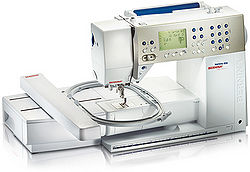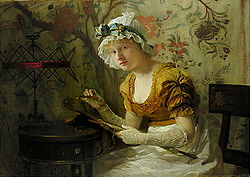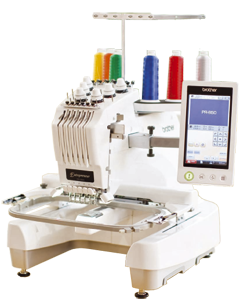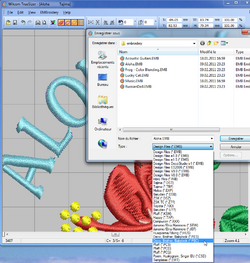Computerized embroidery
<pageby nominor="false" comments="false"/>
Introduction
Many modern sewing machines (including the ones for the home market) can be computer-controlled. Computer-controlled sewing machines are also known as computerized sewing machines. Good sewing machines can sew, stitch and quilt. I.e. you get three machines in one. Computerized embroidery machines can be a different kind of machines. However, many sewing machines can be turned into an embroidery machine by adding a hardware module.
We probably can distinguish between the following kinds of models with respect to computer control:
- computer-controlled (directly from a computer). I imagine that these could exist in industry.
- computer-controlled (via file upload, i.e. specific firmware in the machine will read a proprietary CNC file and execute it). That's the solution existing in mid and high-end home machines (in the $500 to $10000 range). A good model (like a Swiss Bernina that can both sew and stitch will cost around CHF 3000.-). Entry-level computerized embroidery-only machines are not as frequent.
- Computer-powered, i.e. the machine will have more than a single motor and stuff is synchronized with a computer instead of complex mechanics. Typically, low and mid-end home machines.
For the time being, this page will focus on links about computerized embroidery. See also fab lab, an introduction to end user-created design and fabrication. Expect more & better wiki entries if or (rather) when I decide to buy some hardware. For the moment, don't believe anything you can read here. - Daniel K. Schneider 17:02, 19 April 2011 (CEST).
In computer-powered or computer-controlled home sewing machines, “the computer directly controls several different motors, which precisely move the needle bar, the tensioning discs, the feed dog and other elements in the machine. [...] The computer drives the motors at just the right speed to move the needle bar up and down and from side to side in a particular stitch pattern. Typically, the computer programs for different stitches are stored in removable memory disks or cartridges. The sewing-machine computer may also hook up to a PC in order to download patterns directly from the Internet. Some electronic sewing machines also have the ability to create complex embroidery patterns. These machines have a motorized work area that holds the fabric in place underneath the needle assembly. They also have a series of sensors that tell the computer how all of the machine components are positioned. [...] The sewer simply loads a pattern from memory or creates an original one, and the computer does almost everything else.” Computerized Sewing Machines, retrieved 13:07, 15 April 2011 (CEST). With that kind of machines, a user can focus on design and the needs to learn how to interpret orders from machine like replacing the threads.
According to Wikipedia and other sources, the first modern day computer controlled sewing machine was built by Orisol in 1987 for making shoes.
Design software exists in various form. Designs are both sold and also available as open "source". Converter software between various control formats exists, however depending on your sewing machine you will have to make an effort for finding the right tool.
Computerized embroidery
More or less according to Wikipedia, the basic steps for creating an embroidery are as follows:
- Get or create a digitized embroidery design file in some kind of editable source format. Typical formats are .exe, .dst, .cnd and .fdr
- Edit the design and/or combine with other designs (optional)
- Translate to machine executable code, i.e. a stitch file (optional if the original format machine-reable). Typical formats are .pes .art, .pes, .jef, .sew and .hus (see below)
- Load the final design file into the embroidery machine
- Stabilize the fabric and place it in the machine
- Start and monitor the embroidery machine
Creating a digitized embroidery file itself includes at least two steps
- Create a drawing in a format that will remain editable. Some software also allows to import bitmap formats.
- Then digitize (translate) to a common stitching source format (optional) and add embroidery-specific information (e.g. color, stitches, fills, borders).
- Then digitize to a simple machine format (punching).
Specialized low-end software does this in two steps. Get a drawing or picture and then auto-digitize and auto-punch for a specific range of machines. In the middle of the process, you then also can resize, combine, rotate, etc.
Software and repositories for embroidery
Disclaimer: None tested so far, therefore none we could recommend.
We can distinguish between several types of software, although sometimes the frontiers are blurreded.
- Software to create designs for "manual" embroidery
- Vectorizers (can translate a bitmap to vector formats)
- Digitizers (can translate a vector format to CNC code). This is must have.
- Converters can convert from one format to another (may include the above)
- Editors (can draw, but sometimes also vectorize)
- Viewers (allow to view files, useful for script generated formats for example)
- Organizers (help to organize designs on your hard disk)
- Complete embroidery CAD Suites, can create sophisticated drawings (vector based embroidery, VBE) and support all the design stages. Often, the drawing module is based on existing high-end vector graphics software. E.g. Pulse's embroideryi2 is an addon for either Illustrator or Corel Draw. Bernina's Embroidery software is based on Corel.
High-end embroidery software suites should include all of the software types listed above.
It is very difficult to find out what software costs and - funny - where and how to buy. Some companies (like Bernina) seem to sell anything only through authorized resellers. In addition, I couldn't find any up-to-date list that includes any sort of comparison. Add the various numberous obscure file formats and you find yourself in a software jungle that is hard to beat in terms of inacessibility and obscurity.
One also has to pay attention to connectivity. Some machine types use specially formatted memory cards or USB sticks (or some other weird specifics) and do require special software to write CNC files. Usually this type of software is offered for free (either when you buy the machine or for download). The software then also can convert, resize, rotate, preview, etc. If you plan buying any sort of design software, you should check if your type/brand is supported. If not, you always can use a converter but this may be a lossy process.
Design and multi-purpose tools
- Free just design tools
(these will just create patterns for hand stitching)
- KXStitch aims to produce software to allow the creation and editing of cross stitch patterns. Runs under Linux/KDE. See kxstitch wiki
- Free design tools for computerized embroidery
These can output CNC file formats. You may have to use a converter to get it working on your machine.
- Embroidermodder. Free software tool (under development as of April 2011) that allows the user to add custom modifications to their embroidery designs. Can read/write 5-6 formats. Started in 2004 by Mark Pontius, last update on 11/2010 when last checked (April 2011). I installed this on Win 7 64 and the program runs. I created a simple text and was able to save a .dst file and then open it with Wilcom TrueSizer. Some stiches seem to be wrong.
- Rudolf's Sewing / Embroidery related Programs (last updated 2005, not tested). Includes a free conversion program and a simple drawing program creating *.pcs.
- Commercial embroidery/stitching design tools
- BuzzTools sells a series of design tools, e.g. design management software. graphics to stitches, words to stitches, etc. (between $99 and 300)
- Brother, also a maker of sewing machines sells [PED Basic Embroidery Software] (simple editing) and PE-Design light (digitizing, letters, combining, etc. about 300 €). A higher-end product also exists (see below)
- Stitch & Sew made by Compucon has several product levels: Designer (Standard Digitizing & Editing package), Editor (Lettering & Editing package), Embroidery Studio (digitizing & editing). The full package is called Embroidery Studio Plus. No idea how much it would cost.
- Stitches in Motion has Sew Art (software for converting clipart or other forms of raster and vector images into an embroidery file). It can output in PES or JEF. For other formats, you will have to use a conversion program.
- Embird Embroidery Software sells several programs, A base program (Basic Embird) plus several plugins e.g. Embird Studio (digitizing). Can read/write many formats and supports many machine types. The top-end program, Studio (digitizing, lettering, auto-tracing, freehand, conversion of vector files into embroidery) is $150 and is a plugin for the Basic Embird Embroidery Software (basic editing, sizing, stitch editing, etc.). $144 Free demo available. I.e. for $300 one probably gets a good package and it can be tried out before buying. Web site has real information (as opposed to fancy PDF files). Seems to be fairly popular.
- Threadworks is a digitizing program for embroidery machines. Can work together with Embird (see above)
- Embroidery Software from Amazing Designs. Several small software (all for under $200), in particular a digitizer and an editor (of existing designs). Trial versions available.
- ApS-Ethos has several programs. The top-end Virtuoso Plus can edit, letter, digitize, import vector files, etc.
- Fancyworks has a series of products. The top-end Fancyworks Studio Plus (editing, digitizing, lettering, import, etc.) costs $650.
- Designers Gallery seems to sell the same under a different packaging (not sure about this.)
- Artistic Suing Suite. Related to Janome ?
High end commercial design suites for home users
It is difficult to find out who really makes what, how much it costs and what is meant for "prosumers" (advanced home users) as opposed to professionals. I find it interesting that two products are based on Corel Draw and I wonder if there is some common ground. Again, I am quite amazed at how difficult it is to find any information about prices and comparative functionality. Also some of these guys can't make websites. Very easy to become lost, very difficult to find the software pages, too many PDF downloads...
Most sewing/embroidery machine makers sell their own custom software suite. Most of these also work with other brands, i.e. they can digitize into more than one format and (maybe) write to several types of cards or otherwise communicate with a machine. It is difficult to understand what most products can do, except for products based on Corel/Illustrator where at least you can know what you could draw in terms of vector graphics.
- General purpose for the consumer market
- Wilcom DecoStudio “integrates CorelDRAW® Graphics Suite X4 with Wilcom's renowned stitch processor, lettering, monogramming and appliqué tools to create a complete graphics and embroidery software solution”. This product was formerly called Edit/Plus. See also DecStudio at Wilcom. Wilcom also has a product line called Embroidery Studio with several product levels. These are more sophisticated and more expensive (probably over € 10000).
- Embroidery software by Pulse. Pulse creates various products like Tajima DG/ML, Tajima Librarian, Tajima Passport. High end and really expensive. For the home user there is Embroideryi2 for Illustrator or embroidery i2 for Corel. See for example Embroidery i2 (both for Corel and Illustrator) These are rumored to cost just a few thousand $.
- (Rather) brand specific
- Bernina's Embroidery Software (en) based on Corel Draw is about $2000/€ 1500. They sell other products: Software link (en/USA). See also the Swiss version of the software page (de/fr).
- Brother PE-Design NEXT (about € 1500).
- Melco (D) has a line of products known under "Design Shop". See Melco USA: Lite, normal, Pro and Pro+. Melco produces embroidery machines and software prices are not directly communicated ....
- Janome, a sewing machine maker has line of products known as Janome Digitizer Software Series with three software levels Jr, Pro and MB. There is no price list.
- 5D Embroidery Software Packages. This company sells two kinds of high-end packages, one for Husquarna and one for Pfaff. Individual modules can be bought directly from 5D. No price list.
- Husquarna's packaging of the 5D suite for its Viking line, includes 5D™ Professional. This product includes eleven software modules, e.g. design creator (edit/fill/etc), editor, aligner, sketcher, cross stitcher, organizer. Eight of these can be bought separately. Did not see real technical information (i.e. power of the design tools).
- Pfaff's 5D™ embroidery software version.
- Elna has Digitizer EX V 3.0. This product looks more like mid-end software. Price unknown.
- Other
- Embroidery Office (EO11) made by Sierra includes: Art and Design; Design Administration; Production Organization; Machine Connectivity; Catalog Preparation and Spreading. Claims to be very high-end, but their web pages are full or errors and won't display well in FF4 and IE9 ... (on April 19, 2011).
- I-CLIQQ € 1900, is a suite with three levels that is marketed for professionals. Claims to in the same ligue as the multi-thousand competition. (Demo version available).
- Floriani has a larger product line. Embroidery Suite Pro costs € 1600 and includes 8 products, e.g. editing, digitizing, borders, monograms, lettering, resizing. These also can be bought individually. The top-of the line product is € 5000.
- McStich Professional software, fairly useless web site....
Free converter tools and other utilities
- Free utility tools (converters, digitizers, etc.)
Some of these are available as plugins for graphics programs
- Hershey Text: An Inkscape extension for engraving fonts. This is not directly useful, but this extension could be used as "middleware" for an Inkscape to embroidery converter (see below)
- Planned since 2009: The Brother Liberation Front announced working on and Inkscape and Gimp plugin named Yarnscape and Crafty Gimp respectively. If this will happen, then Inkscape could become a free embroidery design tool.
- Embroidery output extension for Inkscape by Jon Howell, 2010. GPL. Easy to install on Linux, needs python and the shapely library. Tested on April 2011 under Ubuntu 10.04. To install:
apt-get install python-shapely cp embroider.inx embroider.py PyEmb.py ~/.config/inkscape/extensions
- In Inkscape, the extension is available in Extensions->Render->Embroider
- Only works, if you create a drawing with filled regions that are converted to pathes and are not grouped. (So no grouping, no strokes, etc. !)
- Result *.exp will sit in your home directory or some other place ...
I managed to create a stitched oval and display it with some *.exp viewer. - April 2011.
- Joachims's freeware include Pesview 1.3.0, a Viewer/Conversion-Tool for PES/PEC/PCS/DST/SEW and EasyPEC for converting PES.x to PEC 1.0
- PES-file thumbnailer by Linus Thorvald himself ! (for Linux, needs pnglib-devel and cairo-devel to comple) Read Embroidery.. gaah January 13, 2010
- Embroidery Reader for PES (Brother)
- Free converters/resizers/etc from commercial companies
- WILCOM TrueSizer. Read, resize, rotate and convert many popular industrial and home expanded/condensed file formats. Can't write .ART. Windows, free but registration is required. Tested under Windows 7 64 bit. Software works, but so far I don't have a sewing machine to test for real (April 2011). Anyhow, as far as I can tell, this seems to be the one of the two best free converters.
- multi-converter from Stitch & Sew. Can read designs from manufacturer's cards to the hard disk and the other way round. Registration required. I Installed it on Win 7/64, but did not understand how I could convert files within my hard disk.
- Bernina Artlink, a free multi-purpose utility program form Bernina. Can resize, rotate 45 degrees, select stitch color, read/write many embroidery formats, display hoops for various types (also other brands), write to various hardware. As far as I can tell, this seems to be the one of the two best free converters. I somehow got the German version, but there is also an English edition ...
- Artistic my editor free viewing and editing software: view and modify supported embroidery files and then re-save them in any of the available embroidery file formats. (not yet tested).
Commercial converters, resizers, etc.
(See also other tools above !)
- SewWhat! from Stitches in Motion. Can read most formats and write a lot of formats (but not .art). Between $50 and $65. Free trial versions.
- StichBuddy converter, resizer, etc. For Mac OS X. Cheap (€ 40) and demo version is available.
- Embrilliance. A (relatively) cheap multi-purpose tool for converting/merging/lettering etc. Supports most embroidery formats, but can't import "normal" 2D graphics. (Mac/PC)
- Mac Embroidery. Multipurpose converter ($ 129).
File formats
There are several kinds of formats, in particular
- All sorts of 2D bitmap and vector formats for the drawings
- Embroidery and sewing specific file formats that work on a range of machines and also can be used as exchange formats.
- Machine formats that are mostly brand or even type specific
- List of formats
Not sure that it is correct. It seems that there are about 20 different formats for me it is not very clear what different formats can do. Also, I don't know how formats are supported by various vendors. If I understand right, some formats are barely editable since they only contain stitching instructions like "go x/y" and "add a stitch from x/y to x2/y2" or "change thread".
I is not very clear what formats a specific machine from various Brands can read. E.g. Bernina's support *.art (a low level CNC format), but it seems that the high-end machines directly can read *.exe which is an editable format.
Vendors include conversion software that can translate to their (and other's) machine readable CNC formats from a series of more high-level formats.
- Some more high level formats (easily editable)
- CND Melco
- DST Tajima
- EMB Wilcom
- EXP Melco (Bernina high-end models)
- FDR Barudan
The most popular formats seem to be DST and EXP
- Some low level CNC formats (lossy for editing)
- ART Bernina
- CSD Singer, POEM
- HUS Husquarna Viking
- JEF Janome
- PCS Pfaff
- PEC Bernina ?
- PES Brother (Bernina?, Bablock, Deco)
- SEW Janome, Elna
- SHV Husquarna Viking
- XXX Singer, Compucon
- VIP Pfaff (older)
- VP3 Pfaff (newer)
- 9mm Pfaff
- PCQ,PCD,PCM ?
The most popular low-level format seems to be *.pes (Brother)
See also examples of what certain software/repositories support:
Free repositories
- Needlework Russia (some free)
- AnnTheGran (some free)
- The 'Automatic Embroidery Machine' System Thingiverse. As of 4/2011 only 3 things .... but that will change ;)
Links
- Sewing and embroidery websites (unsorted)
- k2g2 “is an open platform that is spearheading the brains and crafts movement of the 21st century, taking a hacker's perspective on everything from handicraft to crafting machines”. This website includes good "portals" for machine knitting and machine embroidery. Best resource for open source projects.
- Sewing.org has free sew, quilt and craft projects
- Sewing & Craft Alliance provides educational information and creative resources to the sewing and crafting enthusiast
- SewReview, includes a blog with entries on various topics plus buying guides and reviews
- eHow includes entries about sewing, embroidery, etc.
- rumblr includes a few entries about sewing etc.
- The Embroiderers' Guild of America (EGA). A few interesting links.
- Open Source embroidery
- patternreview Popular site for sharing patterns and advise (including computerized stuff)
- Blogs
- Other links of links
- Embroidermodder has some good links (including broken ones, last update was 2004)
Introductions
(Retrieved April 2011, unless otherwise stated)
- Introductions to embroidery
(there are many, but we keep it down since we are interested in computer-created designs only here)
- Embroidery (Wikipedia). follow-up the various Wikipedia links at the bottom.
- Introductions to computerized embroidery
- Machine embroidery (Wikipedia)
- How to Digitize Embroidery Designs at eHow
- How to Create a Digital Embroidery Design at eHow
- Introductions computerized sewing machine
- Computerized Sewing Machines, at How stuff works (part 3 of How Sewing Machines Work)
- Introductions to normal sewing machine
- Flashback: Anatomy of a Sewing Machine, April 2007 in CRAFT Volume 03: by Christine Haynes and Kent Bell. (mechanical parts)
- How Sewing Machines Work at How Stuff Works (includes good animations)
- Specialized tutorials
- Electro-knit! Hacking the Brother KH-930e knitting machine by Ladyada, March 2011. See also Electroknit Technical Information by Sconklin. (Dec 2010).
- Other
"* computer controlled embroidery?. Discussion about fab labs and tools of culture (fab/MIT)
Software
- Useful websites
- Machine Embroidery Portal at k2g2. It includes pointers to the most of the few open source software and:
- embroidery software which runs natively under Mac OS X (2/2010)
- Online retailers (multiple products)
- embroidery.com
- Amazon sells various embroidery software.
- File formats
- Technical info about formats
- Embroidermodder has links to other pages
- Wotsit.org includes a description and a link for most somewhat popular computer file formats. (you will have to search for stitching/sewing formats).
Hardware
- Computerized Sewing Machines Reviews and Prices at products/how stuff works.
- The Best Sewing Machine Online. Explains some history, how they work and discusses various models (include some that are computer-powered or controlled).
- Best Sewing Machine. Lots of reviews (> 600 models)
- Do it yourself
- Creating a computer-controlled sewing machine, Makezine, 2010.
Bibliography and journals
- Textile Research Journal, Sage.




